Learning Objectives
- Differentiate between photo-, chemo-, auto-, and hetero-trophies
- Distinguish between essential, beneficial, macro- and micro-nutrient requirements for plants and animals
- Recognize that both insufficient and excessive amounts of nutrients can have detrimental effects on organism’s growth and health
- Predict the symptoms of nutrient deficiencies in plants based on whether the nutrient is mobile or immobile in plant tissues
- Describe the diversity of adaptations for acquisition of nutrients in plants, especially nitrogen acquisition
- Describe the diversity of adaptations for acquisition of nutrients in animals, especially mouth structures, presence of specific digestive system structures, and the role of the gut microbiome in digestion
Living Cells Need Materials to Grow: Nutrients
The information below was adapted from OpenStax Biology 22.3
Recall from our discussion of prokaryotes metabolic diversity that all living things require a source of energy and a source of carbon, and we can classify organisms according to how they meet those requirements:
- Classification by source of energy:
- Phototrophs (phototrophic organisms) obtain their energy from sunlight.
- Chemotrophs (chemosynthetic organisms) obtain their energy from chemical compounds.
- Classification by source of carbon:
- Autotrophs (autotrophic organisms) are able to fix (reduce) inorganic carbon such as carbon dioxide
- Heterotrophs (heterotrophic organisms) must obtain carbon from an organic compound
These terms can be combined to classify organisms by both energy and carbon source:
- Photoautotrophs obtain energy from sunlight and carbon from carbon dioxide
- Chemoheterotrophs obtain energy and carbon from an organic chemical source
- Chemoautotrophs obtain energy from inorganic compounds, and they build their complex molecules from carbon dioxide.
- Photoheterotrophs use light as an energy source, but require an organic carbon source (they cannot fix carbon dioxide into organic carbon).
Essential Macronutrients and Micronutrients
The information below was adapted from OpenStax Biology 22.3, OpenStax Biology 23.2, and OpenStax Biology 24.1
Cells are made of more than just carbon; for cells to build all of the molecules required to sustain life, they need certain substances collectively called nutrients. A nutrient is essential if an organism cannot synthesize it and must acquire it from another source. In contrast, a beneficial nutrient can stimulate growth and development but is not required and/or could be substituted by another nutrient.
Essential nutrients that are required in large amounts are called macronutrients, and those required in smaller or trace amounts are called micronutrients. Just a handful of elements are considered macronutrients across all domains of life: carbon, hydrogen, oxygen, nitrogen, phosphorus, and sulfur. (A mnemonic for remembering these elements is the acronym CHONPS.)
- Carbon is the major element in all biological macromolecules: carbohydrates, proteins, nucleic acids, lipids, and many other compounds. Carbon accounts for about 50 percent of the composition of the cell.
- Nitrogen represents 12 percent of the total dry weight of a typical cell and is a component of proteins, nucleic acids, and other cell constituents. Most of the nitrogen available in nature is either atmospheric nitrogen (N2) or another inorganic form. Atmospheric (N2) nitrogen, however, can be converted into an organic form only by certain organisms, called nitrogen-fixing organisms.
- Both hydrogen and oxygen are part of many organic compounds and of water.
- Phosphorus is required by all organisms for the synthesis of nucleotides and phospholipids.
- Sulfur is part of the structure of some amino acids such as cysteine and methionine, and is also present in several vitamins and coenzymes.
- Depending on the organism, other important macronutrients include potassium (K), magnesium (Mg), calcium (Ca), and sodium (Na).
In addition to these macronutrients, cells require micronutrients or trace elements, which are elements needed in small amounts. For example, iron (Fe) is necessary for the function of the cytochromes involved in electron-transport reactions.
Nutritional Needs in Plants
The information below was adapted from OpenStax Biology 31.1, OpenStax Biology 31.3, OpenStax Biology 24.3
Plants require light, water and about 20 essential nutrients (including both macro- and micronutrients) to support all their biochemical needs. Depending on the species, some plants have additional essential nutrients. Here we will describe only a handful of essential macronutrients that are common to all plants:
- Carbon (C) from the air is used by plants to make glucose (sugar) which can be ultimately used to construct cellulose. Cellulose is the main structural component of the plant cell wall, and it is the most abundant organic compound on earth.
- Nitrogen (N) is part of proteins and nucleic acids, and is also used in the synthesis of some vitamins. While there is an overwhelming amount of nitrogen in the air (79% of the atmosphere is nitrogen gas), the nitrogen in the air is not biologically available due to the triple bond between the nitrogen atoms. Only a few species of bacteria are capable of “fixing” nitrogen to make it bioavailable; thus nitrogen is often a limiting factor for plant growth.
- Phosphorus (P) is necessary to synthesize nucleic acids and phospholipids. As part of ATP, phosphorus enables food energy to be converted into chemical energy through oxidative phosphorylation. Likewise, light energy is converted into chemical energy during photophosphorylation in photosynthesis, and into chemical energy to be extracted during respiration. Phosphorous is typically available in a form that is not readily taken up by plant roots; the form that is bioavailable is present in small quantities and rapidly “fixed” into the bioavailable form once again. Phosphorus is therefore often a limiting factor for plant growth.
- Potassium (K) is important because of its role in regulating stomatal opening and closing. As the openings for gas exchange, stomata help maintain a healthy water balance; a potassium ion pump supports this process. Potassium may be present at low concentrations in some types of soil, and potassium is the third most common limiting factor for plant growth.
Based on the information above, you might not be surprised to learn that nitrogen, phosphorus, and potassium are the three most common components in commercial fertilizers.
Plants are able to continuously acquire carbon from the air (in the form of carbon dioxide); however, as stationary organisms nutrient acquisition can become a challenge if the soil becomes depleted of a particular nutrient. Most land plants address this challenge by continually growing roots throughout the soil as they mine for minerals and water.
Both deficiencies and excessive amounts of nutrients, whether macronutrients or micronutrients, can adversely affect plant growth. Deficiencies occur when a plant does not have enough of a particular nutrient to support biological functions performed by that nutrient. Conversely, excessive amounts of some nutrients can be toxic to certain tissues or cell types.
Depending on the specific nutrient, a deficiency can cause stunted growth, slow growth, or chlorosis (yellowing of the leaves). Extreme deficiencies may result in leaves showing signs of cell death. The symptoms of a given nutrient deficiency depends partly on the nutrient’s function, and partly on whether the nutrient is mobile within the plant tissue:
- if a plant depletes the soil of a nutrient that fixed into existing tissue and cannot be moved to a different tissue, then new growth will show signs of the deficiency
- if a plant depletes the soil of a nutrient that is mobile within the plant tissue, then old growth is likely to show signs of the deficiency rather than new growth, because plant is likely to move the nutrient from older to newer tissues

Adaptations for Nutrient Acquisition in Plants
The information below was adapted from OpenStax Biology 31.1, OpenStax Biology 31.3, OpenStax Biology 24.3
Plants generally obtain carbon in two different ways:
- Autotrophic plants can make their own food from inorganic raw materials, such as carbon dioxide and water, through photosynthesis in the presence of sunlight. Green plants are included in this group.
- Heterotrophic plants lack chlorophyll and thus are unable to synthesize their own organic carbon; instead, they are parasitic and draw all of their nutrients from a host plant:
Acquisition of other nutrients (for example, nitrogen, phosphorous, and potassium) generally occurs via the roots which are embedded in soil for most plants; however, there are many variations and adaptations across plant groups to support this process (especially for nitrogen acquisition):
- Mycorrhizal fungi: most plants (~80-90%) rely on mycorrhizal fungi to facilitate the uptake of mineral nutrients from the soil. Fungi form symbiotic associations called mycorrhizae with plant roots, in which the fungi actually are integrated into the physical structure of the root. Mycorrhizae help increase the surface area of the plant root system because the fungal hyphae can spread far beyond the plant root system; as a result, the plant obtains nutrients such as nitrogen and phosphorus from the soil or organic matter decomposed by the fungi, and the fungus obtains sugars and other nutrients from the plant root. Mycorrhizae also function as a physical barrier to plant pathogens.
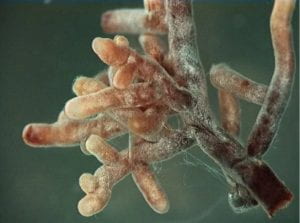
- Legumes and nitrogen-fixing bacteria: nitrogen is the most abundant element in Earth’s atmosphere; however, atmospheric nitrogen is not biologically available to plants. The process of biological nitrogen fixation (BNF) coverts atmospheric nitrogen (N2) to ammonia (NH3); this process is carried out exclusively by a few species of nitrogen-fixing bacteria. The most important source of BNF is the symbiotic interaction between soil bacteria and legume plants, including many agricultural crops important to humans such as peanuts, beans, chickpeas, soybeans, and lentils (among many others).
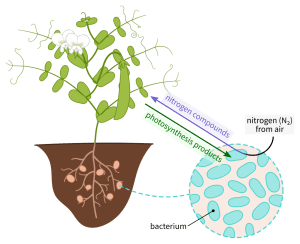
- Carnivorous plants: Carnivorous plants have specialized leaves that and digest insects or small vertebrates, typically as an adaptation to supplement nutrient access in extremely nutrient-poor soils. Examples include Venus flytrap, pitcher plants, and sundews. Once trapped, fluids and enzymes break down the prey and nutrients are absorbed by the leaf. It is important to note that carnivorous plants are autotrophic rather that heterotrophic (they synthesize their own carbon via photosynthesis); they are carnivorous not to acquire carbon, but to acquire other nutrients that are unavailable in their nutrient-poor soils.
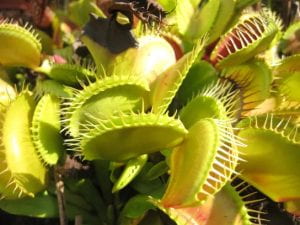
Nutritional Needs in Animals
The information below was adapted from OpenStax Biology 34.0, OpenStax Biology 34.1, and OpenStax Biology 34.2
Like all forms life, animals require (at minimum) carbon, hydrogen, oxygen, nitrogen, phosphorus, and sulfur as building blocks for biological molecules. Unlike photoautotrophic plants we have just described, which obtain their required energy from the sun and their required nutrients from carbon dioxide in the air and nutrients from the soil, animals are chemoheterotrophs and must obtain both their energy and their nutrients by eating other organisms. Animals can be classified based on the type(s) of organisms they eat (more on this concept later on in this reading):
- Herbivores are animals that primarily eat plants
- Carnivores are animals that primarily eat other animals
- Omnivores are animals that eat both plants and animals
Animals obtain their energy and nutrients from three primary organic precursors:
- Carbohydrates (including both simple and complex sugars) are the primary source of organic carbon for herbivores and omnivores; carnivores must rely on protein and lipids as sources of carbon.
- Proteins are dietary sources of nitrogen and sulfur (and carbon for carnivores).
- Fats are also significant sources of chemical energy, producing more energy per gram than carbohydrates. Dietary fats are also necessary to aid the absorption of fat-soluble vitamins and the production of fat-soluble hormones.
While the animal body can synthesize many of the molecules required for function from the organic precursors, there are some nutrients that need to be consumed from food. These nutrients are termed essential nutrients, meaning they must be eaten because the animal cannot synthesize them. Essential nutrients vary among animal species (for example, almost all mammals can synthesize vitamin C; exceptions include humans, non-human primates, guinea pigs, and bats which must have a dietary source of vitamin C). The four classes of essential nutrients are:
- Essential amino acids are necessary as protein building blocks. For humans, all essential amino acids are available from meat sources; because there are no plants that contain all essential amino acids, vegetarians and vegans must eat sufficient quantities of both grain and legume protein sources
- Essential fatty acids are necessary as fat building blocks (also used as signaling molecules and many other functions). For humans, there are only two essential fatty acids, as we are able to synthesize nearly all of the fatty acids needed.
- Vitamins are organic compounds needed in small amounts. Vitamins may be water-soluble (such as vitamin C), meaning they are easily excreted in urine, or fat-soluble (such as vitamin D), meaning that the can accumulate in adipose (fat) tissue.
- Minerals are inorganic compounds needed in small amounts. Minerals include a variety of elements such as calcium, phosphorus, sulfur, potassium, sodium, iron, and many others.
As with plants, both deficiencies and excessive amounts of nutrients can adversely affect animal growth and health. Deficiencies occur when an animal does not have enough of a particular nutrient to support biological functions performed by that nutrient. Conversely, excessive amounts of some nutrients can be toxic to certain tissues or cell types.
The video below provides an overview of the nutritional needs of humans:
Adaptations for Nutrient Acquisition in Animals
The information below was adapted from OpenStax Biology 34.0, OpenStax Biology 34.1 OpenStax Biology 34.2
As noted above, animals obtain both nutrients and energy by eating other organisms. At the cellular level, the biological molecules necessary for animal function are amino acids, lipid molecules, nucleotides, and simple sugars. However, the food consumed consists of proteins, fats, and complex carbohydrates. Animals must convert these macromolecules into the simple molecules required for maintaining cellular functions like assembling new biological molecules. The conversion of the food into nutrients is a multi-step process involving digestion and absorption. During digestion, food particles are broken down to smaller components, and later, they are absorbed by the body (more on digestion and absorption later in a future reading).
As noted above, animals can be classified into the following categories based on their diet:
- Herbivores are animals whose primary food source is plant-based. Examples of herbivores include vertebrates like deer, koalas, and some bird species, as well as invertebrates such as crickets and caterpillars. These animals have evolved digestive systems capable of handling large amounts of plant material, which require additional digestive processing steps compared to animal material. Herbivores can be further classified into frugivores (fruit-eaters), granivores (seed eaters), nectivores (nectar feeders), and folivores (leaf eaters).
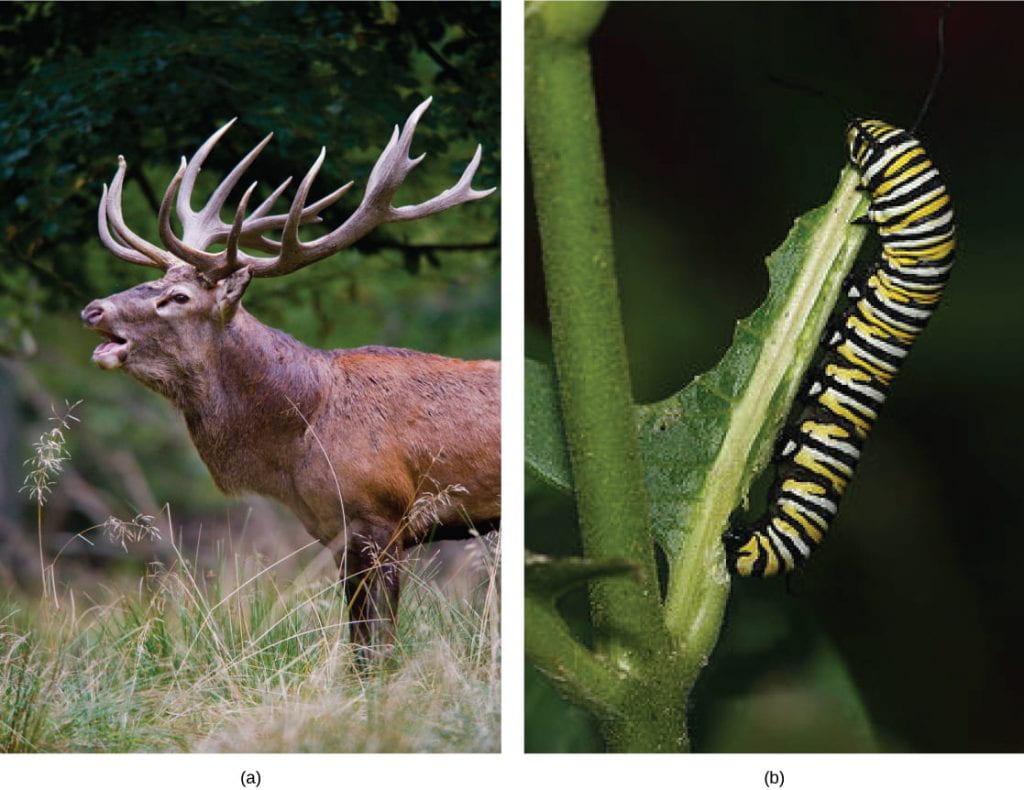
- Carnivores are animals that eat other animals. Lions, tigers, snakes, sharks, and orcas (killer whales) are examples of vertebrate carnivores; invertebrate carnivores include sea stars, spiders, and ladybugs.

- Omnivores are animals that eat both plants and animals. Humans, bears and chickens are example of vertebrate omnivores; invertebrate omnivores include cockroaches and crayfish.
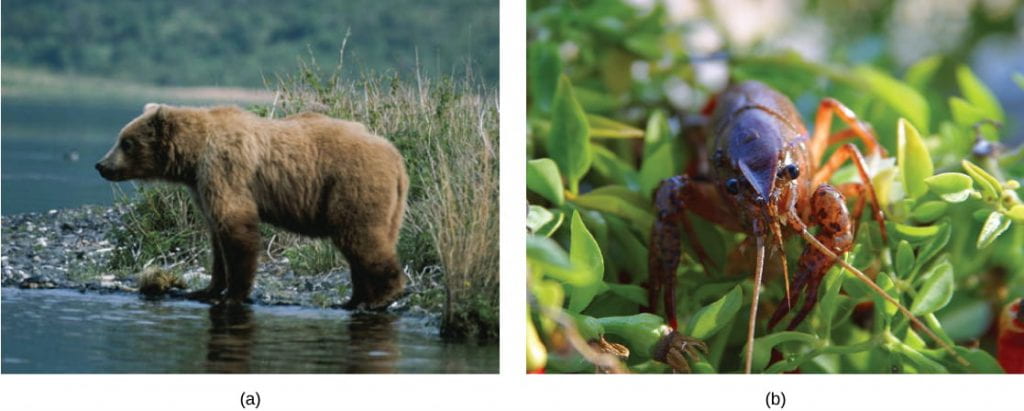
Regardless of what an animal eats, it must ingest (swallow) its food in order to digest it (contrast this process with that of fungi, which are chemoheterotrophs like animals, but which secrete digestive enzymes outside of their body to break down food before absorbing the nutrients through their hyphae). There are many adaptations across animal species to facilitate ingestion and digestion of different food sources:
Example adaptations for ingestion of different foods:
- Invertebrate mouth parts: Invertebrates lack teeth, but demonstrate a wide array of mouth structures that are adapted to different food types; for example, among insects:
- bees have structures that facilitate lapping up of nectar
- grasshoppers have structures to support chewing of vegetation
- butterflies have straw-like structures that allow for siphoning of nectar
- Jaw structure: Vertebrate jaw structure varies widely across species; for example, snakes have an extra bone on either side of the jaw, as well as flexible tendons joining the center of the lower jaw, which allow snakes to open their jaws wide enough to swallow prey that appears to be larger than their heads
- Teeth: Among vertebrates with teeth, different types of teeth are adapted to different types of foods:
- Incisors work well for biting
- Canines work well for tearing chunks of food from a larger mass; canines tend to be larger in carnivores
- Molars work well for chewing; molars tend to be flatter and more numerous in herbivores and omnivores
Example adaptations for digestion of different foods:
- Symbiotic microorganisms: the digestive tract of all animals contain symbiotic microorganisms which perform their own digestion of food within the animal. In most cases, the relationship is mutually beneficial: the microorganisms have a steady supply of nutrition and live within a controlled environment protected from predators, and the animal has access to the nutrient byproducts produced by the microorganisms as a result of their digestive activities. In fact, many vitamins and other nutrients, such as vitamin K, are inaccessible in food materials until released by the digestive activity of symbiotic bacteria in an animal’s gut
- Cecum and rumen: digestion of plant material requires additional steps and is far less efficient compared to digestion of animal material; in addition, some digestive steps of plant materials can only be performed by microorganisms. Herbivores have a variety of adaptations to house and support specific symbiotic bacteria within their digestive tract; in turn, these bacteria ferment plant fibers and other plant material which releases nutrients which would otherwise be unavailable to the animal. This process the bacteria and also makes more nutrients available to the animal host. These digestive structures include:
- a large cecum (present in non-ruminant herbivores, such as rabbits and other herbivorous rodents), which is a side pouch of the large intestine that houses symbiotic bacteria (the appendix is the vestigial cecum in humans)
- a rumen and associated organs (present in ruminant herbivores, such as cows), which is essentially a fermentation vat within the digestive tract to house symbiotic bacteria and protists capable of digesting cellulose
- Gizzard: in both invertebrates and vertebrates that lack teeth entirely (such as birds) or teeth/jaw structure to support chewing (such as many reptiles), the gizzard is often the side of mechanical breakdown of food. The gizzard is a stomach-like chamber that combines powerful muscle contractions as well as small pebbles, sand, or grit eaten by the animal to mechanically break down food items to facilitate their digestion.

